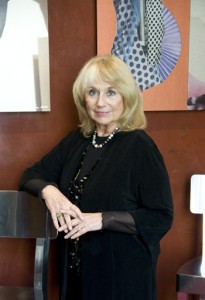Barbara Nessim | Illustrator
 You may have seen the collage on the cover of the 2010 issue of Harper’s Magazine with snippets of photographs of women’s faces superimposed on classical stone sculptures. You may also have read the 1997 New York Times Magazine cover story on breast cancer, a single line representing a breast in profile. And there’s a good chance you remember the 1988 Rolling Stone magazine tribute to John Lennon; the cover a simple rendering of Lennon’s face, with just a few strokes re-creating his gentle face and granny glasses.
You may have seen the collage on the cover of the 2010 issue of Harper’s Magazine with snippets of photographs of women’s faces superimposed on classical stone sculptures. You may also have read the 1997 New York Times Magazine cover story on breast cancer, a single line representing a breast in profile. And there’s a good chance you remember the 1988 Rolling Stone magazine tribute to John Lennon; the cover a simple rendering of Lennon’s face, with just a few strokes re-creating his gentle face and granny glasses.
If you’ve seen any of these images, you know the work of Barbara Nessim (Pratt Institute, B.F.A. ’60), a prolific New York illustrator and studio artist who has signed her name to thousands of magazine and advertising illustrations—many of them now iconic.
Nessim attended Pratt in the late 1950s, and, she says, she rarely got the impression her professors or fellow students thought she would be successful.
“Everyone was into listening to jazz, wearing black, and being depressed,” she remembers. “I wasn’t into all that.” Nessim’s other passion besides art was Latin dance. “I would come to school all dressed up, because I never knew if I was going to stop and go dancing at the Palladium on my way home.”
Home was an hour and a half away in the Bronx, where she lived in a two-bedroom apartment with her parents, and her brother and sister. She did not mind the close quarters, or the commute.
“I’d take three trains with my T-square and my pads, but I didn’t mind it,” she says. “I loved school and I loved going to school.”
Nessim recalls an important moment from her time at Pratt, when her painting teacher Walter Murch discovered that, aside from the abstract painting assignments she was doing for class, Nessim was also creating small more realistic paintings that had a narrative.
“I was lovelorn,” she explains. “And I would paint these little things that would make me feel better.”
One day, Murch happened to catch sight of them and was shocked—and complimentary.
“That’s when the light bulb came on,” she says. “Art is something that comes from you. It’s your own story in a way.”
When she graduated, Nessim continued to live at home, working as a textile designer three days a week for $25 a day. “The other two days I would take my portfolio around to art directors and on the weekends I would do any illustrating job I was lucky enough to get.”
Her first success came soon after graduation, when she earned a special mention in a juried exhibition by the prestigious Society of Illustrators. Ironically, she remembers, her professor Richard Lindner, who used to tease her for the way she dressed, was one of the judges.
She started getting work, at first “only from girlie magazines” (though she was never asked to do “x-rated” work). Then other commissions came—Esquire and Show magazine. After three years she had saved enough to move into an apartment in Manhattan, the first of many she would share first with her sister, then with Ms.magazine founder Gloria Steinem.
Except for her first mention by the Society of Illustrators, Nessim does not recall one big break. Rather, she says, she built her career steadily, image by image. Nessim’s work is now held by, among other places, the Victoria and Albert Museum in London, the Smithsonian Institution in Washington, D.C., and the Norman Rockwell Museum in Stockbridge, Massachusetts, which also named Nessim its first Artist Laureate. Also an educator, Nessim chaired the illustration department at Parson’s The New School for Design between 1992 and 2004.
Nessim has also had several commissions to place her large-scale art into Manhattan buildings. In 2010, she installed her series Chronicles of Beauty into the ballroom levels of the elegant new Eventi Hotel in Chelsea.
The 13 collages on aluminum, similar to the Harper’s cover, merge modern forms with Greco-Roman busts decorated with contemporary accessories—pearls, high heels, animal-print fabric—to explore androgyny, and 3,000 years worth of perceptions of beauty. They are striking; the centerpiece of the series, A Current Past, stands 28 feet high and reaches from the third to the fourth stories of the hotel.
The idea for the commission stems from Nessim’s 2009 Model Project series, in which she worked with a model and photographer to re-imagine beauty through a series of collages and large-format drawings.
Though Nessim has worked on many different types of projects throughout the years, one thing has remained constant: Nessim’s sketchbooks. Nessim has been working out her ideas in her sketchbooks for almost her entire career; she returns to them over and over when she is at a loss for inspiration.
She imposes rules on them: She may not tear out any pages, and each book must have a beginning and end, with dates. “I have to see everything, even things I don’t like.”
In September 2010, Nessim returned to Pratt for her 50th reunion, and reflected on her four years at Pratt, and her career to date, and believes there is one thing that has led to her success.
“I had a secure center. I was happy with me. If I tried, I couldn’t play a part—I can’t be but who I am.”
Photo: Diana Pau
[nggallery id=6]